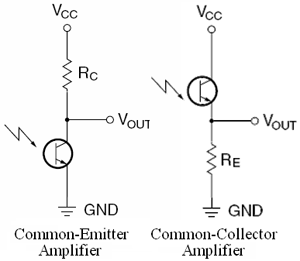Difference between revisions of "Photodiodes and Phototransistors"
From Mech
Jump to navigationJump to searchm (→Comparison) |
m (→Applications) |
||
| Line 31: | Line 31: | ||
==Applications== |
==Applications== |
||
* '''Optocoupler''' |
|||
*: Optocouplers are used in electronics-sensitive applications. For example, you may use this in a mobile robot application to separate the microcontroller circuitry (low voltage/power) from the motor driver circuitry (high voltage/power). |
|||
[[image:optocoupler.png|center]] |
|||
==References== |
==References== |
||
Revision as of 14:45, 6 July 2006
Phototransistors
Phototransistors are transistors with the base terminal exposed. Instead of applying a voltage to the base, the photons from striking light activate the transistor. Other than that, the phototransistor behaves just like a normal transistor. Two common configurations are shown on the right.
- Common-Emitter Amplifier - goes from "high" to "low" with light.
- Commond-Collector Amplifier - goes from "low" to "high" with light.
The phototransistor can be used in two different modes: 1) active & 2) switch. These modes are controlled by changing the value of the resistor. The equations are:
Fairchild recommends a 5kohm resistor or greater to use as a switch
- Switch Mode - when operating as a switch, the transistor can be switched between the cut-off ("off") and saturated ("on") states. This means that when light strikes the phototransistor, it will conduct. Otherwise, it will insulate.
- Active Mode - In active mode, the output of the transistor is proportional to the intensity of the light.
Photodiodes
Comparison
- Frequency Response
- Photodiodes are much faster than phototransistors
- Gain
- Phototransistors have a higher gain
Applications
- Optocoupler
- Optocouplers are used in electronics-sensitive applications. For example, you may use this in a mobile robot application to separate the microcontroller circuitry (low voltage/power) from the motor driver circuitry (high voltage/power).
References
- Fairchild Semiconductor, "Design Fundamentals for Phototransistor Circuits," PDF,


